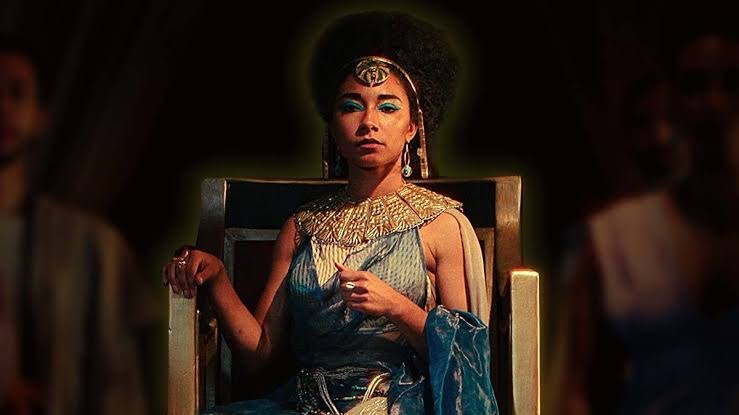
The Afrocentric movement has recently made widespread claims regarding the African origins of ancient Egyptian civilization, as represented by the 2023 Netflix film ‘Cleopatra,’ and the visit by one of the movement’s prominent theorists to the Egyptian Museum in Tahrir, followed by numerous news articles and comments supporting the movement’s ideas.
Professor Wasim al-Sisi confronted these claims with an article in the Al-Masry Al-Youm newspaper titled ‘The Imposters’ and a detailed article in Egypt Independent published on July 24, 2024, titled ‘An overview of the Afrocentric movement, its many lies, and what science really says,’ responding scientifically and culturally to the false claims of this movement.
In response, founding Afrocentrist thinker Molefi Kete Asante published his own rebuttal to the Egypt Independent story, attempting to refute the response against Afrocentrism and defend the ideology.
We invited Professor Wasim al-Sisi in turn to respond and refute these claims, and asked him the following:
Who is Mr. Molefi Kete Asante, described as the leading theorist and leader of the Afrocentric movement?
He is an American university professor of African descent and is considered one of the most prominent specialists in African American studies. He currently works as a professor at Temple University and is the head of the Molefi Asante Institute for Afrocentric Studies.
He is the author of more than 66 books and the editor and founder of the Journal of Black Studies.
He founded the Afrocentric movement with Cheikh Anta Diop and led it after Diop’s death in the 1980s. His main ideas are that African history and culture originated from ancient Egypt and that the origin of Egyptian civilization is African.
He claims that the African heritage of Egyptian civilization has been stolen and falsified by Europeans and Westerners.
What prompted Mr. Asante to write an article on July 27, 2024, in response to your article in Egypt Independent?
Addressing the Egyptian reader in Arabic in the media usually does not reach abroad, but the article I published in English immediately reached Mr. Asante, who is the leader of this group, prompting him to respond quickly.
This in itself is a success for the campaign I am honored to participate in to defend the civilization of Egypt against the lies of the Afrocentric group who seek to steal the ancient Egyptian civilization.
I then contacted my friend, Professor Tarek Taha, a consultant in genetics and regenerative medicine, to prepare a detailed scientific response to Mr. Asante’s claims.
He is a specialist in this field and has internationally published research on the distinctiveness of Egyptian genes. He is also considered one of the Egyptian intellectuals who have made significant contributions over the past two years in responding to the claims of the Afrocentric movement.
Professor Tarek Taha’s full response:
First, I extend my sincere thanks to Professor Wasim al-Sisi for his steadfast position in defending the civilization and culture of Egypt.
I also thank your esteemed newspaper for your interest in this increasingly critical issue, which requires the concerted efforts of Egypt’s scholars and intellectuals to respond to it.
I express my complete rejection of all the claims promoted by the Afrocentric group regarding ancient Egyptian civilization, which are not based on documented scientific evidence but on unfounded statements and texts taken out of context.
At the same time, we affirm our deep respect and appreciation for our brothers in the African continent and Africans around the world.
There is no enmity between us and them; we are, in fact, African nations by geography and strategic location.
We will not allow anyone to create discord between us and our brothers in our African continent, nor between the people of one Egyptian nation, including our Nubian brothers.
Historical truth confirms that Egypt has been distinguished by cultural and ethnic diversity since ancient times, and almost all the civilizations of the world have passed through it.
This was a major reason for its distinction among the countries of the ancient and modern world, as Egypt was able not only to culturally assimilate these civilizations within the Egyptian culture but also to maintain the homogeneity and harmony of Egyptian genes, as proven by the research of American geneticist Margaret Kendall and confirmed by the research of Dr. Tarek Taha in this field.
We appreciate the contributions of all races that contributed to building this ancient civilization, but we affirm that it is an Egyptian civilization built by historically known and documented Egyptian rulers.
Some claims made in this era will not be able to hijack this great civilization.
A detailed rebuttal to Mr Astante:
Mr. Asante’s focus is on the claim that the “Arabs in Egypt” have mostly sought to remove ancient Africans from their history and claim the ancient Kemetic history (as they call Egypt) as Arab history!
He says that the only imposters are those who claim that ancient Kemet, the land of the blacks, was an Arab land.
He interprets this hostility towards Arabs with the idea of Arabs enslaving Africans during the period following General Amr ibn al-As’s invitation to Kemet to help the blacks, the original ancient Egyptians, expel the Romans in 639 AD.
Response: Mr. Asante’s hostility towards Arabs is very clear, and his ideas contradict historical facts. He needs to review them, especially the claim that the original black inhabitants of ancient Egypt invited Amr ibn al-As to enter Egypt to help them expel the Romans, in addition to his claim that Arabs sought to steal the history of ancient Egypt and remove its original African inhabitants.
Mr. Asante said that ancient Kemet, just like Kush, Libya, and Tunisia, was a land of black people, a purely African civilization.
Response: It is clear here that the problem goes beyond Egypt and its civilization; the attack also includes the civilizations of Libya and Tunisia, and scholars in these ancient civilizations must also confront these lies.
Mr. Asante said that Menes came from Upper Egypt, which was inhabited by black-skinned people, and that the inhabitants of Egypt moved along the Nile from within Africa and joined migrating groups from the Sahara. He cites Cheikh Anta Diop, who said that the ancient Egyptians were black Africans.
Response: Where did Mr. Asante get these undocumented pieces of information that he presents as facts? The truth is that they are merely his ideas and those of his group.
Mr. Asante claims racism fuels the logic behind the desire to separate Egypt from Africa.
Response: This is an unjust statement.
Egypt is proud of its African origins as much as it is proud of its Arab and Middle Eastern origins. Egypt is undoubtedly the melting pot of global genetics, where all civilizations have merged over time, making it unique and distinguished. This is not a personal opinion but the result of scientific research conducted by Dr. Tarek Taha in Egypt, confirmed by other international research in Algeria and Sarajevo.
Mr. Asante said that the images and statues of Queen Tiye are undoubtedly of a black woman and that the strongest statues of King Tutankhamun are the two large statues of him as a black person found in his tomb.
He claims that Queen Tiye and her grandson Tutankhamun were not Arabs, but were African culturally, geographically, and linguistically. Their connection to the Nubians is supposedly much closer than the relationship between Queen Tiye and Arab culture.
Response: Simply looking at the statue of Queen Tiye refutes these claims, and the mask of Tutankhamun clearly testifies to the lack of credibility therein. No one claimed that Queen Tiye and King Tutankhamun were Arabs, and here again, Mr. Asante’s hostility towards anything Arab is evident.
As for scientific research, we present the results of genetic studies that prove beyond a doubt the Egyptian origin of both Queen Tiye and Tutankhamun and the rest of the royal family, based on the research published in the Journal of the American Medical Association (JAMA) by Dr. Zahi Hawass’s research group, analyzed by Dr. Tarek Taha, showing the genetic similarity percentages in Tutankhamun’s royal family as follows:
- Between Queen Tiye and Yuya (her father): 56 percent
- Between Queen Tiye and Thya (her mother): 50 percent
- Between Queen Tiye and Amenhotep III (husband): 18.7 percent
- Between Queen Tiye and the son (Akhenaten or Smenkhkare) the tomb man: 56 percent
- Between Queen Tiye and the grandson (Tutankhamun): 43.7 percent
These results confirm that Queen Tiye was from Egyptian parents, she was the mother of Akhenaten or Smenkhkare, and her grandson was King Tutankhamun.
Mr. Asante said that Herodotus claimed: “The people of Colchis were black-skinned and had woolly hair.”
Response: As Professor Wasim al-Sisi pointed out, Herodotus’s visit occurred during the Nubian invasion of Egypt during the 25th Dynasty, which lasted for 60 years from 715 BC to 655 BC.
Mr. Asante and followers of Afrocentric thought claim that the broken noses of ancient Egyptian statues were evidence of black features that Arabs tried to hide to erase the ancient African Kemetic civilization in Egypt.
Response: As Professor Wasim al-Sisi pointed out, the breaking of the noses of ancient Egyptian statues was according to a spiritual belief to allow the soul to leave the body after death.
Mr. Asante said that the history of the Copts in Egypt is less ancient than that of the Kushites, as the Copts are linked to the Greeks who became Christians during the early part of the new era, around 100 AD. Today, they have a strong connection to their Greek origins, but they have retained some fundamental ideas of the ancient Kemetic language.
Response: This statement is completely rejected.
The Copts of Egypt are as much the origin of this country as their Muslim brothers. Scientific research by Dr. Tarek Taha has proven the genetic unity of both groups. Egypt was simply Amunian during the period of ancient Egyptian civilization, then converted to Christianity when Christianity entered Egypt, and then part of its population converted to Islam with the arrival of the Islamic conquest, while the rest of the population remained Christian.
The Copts of Egypt have no connection to the Greeks, with full respect to this ancient civilization.
Regarding the false claims about Queen Cleopatra VII being dark-skinned, Mr. Asante cited the topic of her half-sister Arsinoe IV. Mr Astante claims that Cleopatra VII’s sister, Arsinoe IV, was of black African origin according to her DNA. He said, “It is not an exaggeration to say that Cleopatra VII, her sister, also had similar DNA.”
Response: The historical context of Cleopatra VII’s origin indicates that she was from a Ptolemaic family of Greek Macedonian origins. To date, the location of Cleopatra’s tomb or her remains has not been identified. The suggestion of her African origins challenges traditional historical narratives.
The remains found in Ephesus, Turkey, in 2009, believed to belong to Arsinoe IV, Cleopatra VII’s half-sister, have been debated. Some scholars question the identification of these remains due to the lack of conclusive evidence linking them to Arsinoe IV.
A study conducted by a researcher at the Austrian Academy of Sciences, Hilke Thuer, suggested African origins for Arsinoe IV’s remains, claiming that her mother was African based on skull features. However, scientists have noted that this method is limited in results and not as conclusive as genetic analysis.
Nevertheless, studies by experts in this field have confirmed that her nose is a clear indication of her ancient Greek origins, and she does not possess the distinctive features of sub-Saharan Africans, but she is generally African considering that Egypt is in North Africa.
The DNA analysis of the remains believed to belong to Arsinoe IV has faced numerous criticisms, primarily due to the age and condition of the bones, making it difficult to obtain reliable, uncontaminated DNA samples. As a result, the conclusions drawn about Arsinoe IV’s origins are not universally accepted.
Even researcher Hilke Thuer himself stated that the DNA results did not yield the desired outcomes.
Additionally, the scientific paper containing the DNA analysis of Arsinoe IV has not been widely published in international journals.
There is also no scientific way to prove that she was Cleopatra VII’s sister, due to the absence of Cleopatra VII’s mummy, and thus no DNA for comparison with her alleged sister.
Archaeological and scientific research has described Cleopatra VII as having the distinctive Greek features and characteristics of the Mediterranean and North Africa, with an olive skin tone.
A coin discovered in 2007 and displayed at Newcastle University depicted her as Greek Macedonian in race and appearance.
Mr. Asante responded to the Max Planck Institute’s research on the mummies that underwent genetic study by saying: “By studying these mummies, it occurred to me that this area might have been a region settled by the Hyksos (Heka Khasut) who invaded the city of Kemet around 1400 BC upon their conquest of Lower Egypt. It is likely that their descendants have genetic material linked to the peoples of Southwest Asia from where they came before invading Egypt. The mummies came from Fayoum, which was known as a place settled by many foreigners, including the Hyksos, and especially the Greeks.”
Response: This institute is one of the most important research institutes in the world in the field of genetic studies, and none of the leading scientists and experts in this field have ever disputed its results.
Assumptions are not the basis of science, as Mr. Asante assumed that these mummies were of the Hyksos who occupied Egypt for a period of time, an assumption that is not based on any scientific or historical evidence.
Mr. Asante attacked the 2017 Schoenemann study by Stanford and Barcelona universities, viewing it as biased and controversial, and claimed it is used by ‘ideologists’ like Dr. Wasim al-Sisi to try to remove Africans from ancient Egypt and replace them with Arabs.
Response: Mr. Asante mentioned in his response that in 2023, Stiebling and Helvet acknowledged that the 2017 study was the largest study conducted on ancient Egyptians.
However, they pointed out that the results are still derived from a small sample of mummies from a single site in Middle Egypt dating back to the New Kingdom and later periods.
What Mr. Asante mentioned in his response is actually an acknowledgment of the strength of this scientific research.
Mr. Asante described Professor Wasim al-Sisi’s report on the Cambridge University research as misleading, saying that the summary of the article written by Pagani et al. states: “The predominant African origin of all contemporary human populations is well known, but the route they took out of Africa remains unclear. Two alternative routes have been proposed, via Egypt and Sinai or via the Bab-el-Mandeb Strait to the Arabian Peninsula, as possible gateways considering the ancient geographical, climatic, archaeological, and genetic evidence. Some believe the route was through Morocco to Europe.”
Response: Mr. Asante’s description of Professor Dr. Wasim Al-Sisi’s report on the Cambridge University research was published in the American Journal of Human Genetics and known in the media through the Daily Mail as “Egyptian in All of Us”, so misleading is a strange description.
I do not know what is misleading about it, as the results are published and strong.
The results state that the genetic remnants in the current Asian and European populations included in the research showed a great similarity with the current Egyptian population, compared to the current Ethiopian population. The research concluded that these genes of the Asian and European populations seem to have separated from the Egyptian genes 55,000 years ago.
The research is published, and Mr. Asante only needs to review it to know who Egypt is according to the words of Cambridge scientists themselves.
Mr. Asante claimed that there is DNA evidence of a cultural connection between Kemet and the peoples of Central and West Africa. He said: “As early as 2012, two mummies from the 20th dynasty, Ramses III and the ‘Unknown Man’ believed to be his son Pentawer, were analyzed by a team led by Albert Zink and Yehia Zakaria Gad and others. Genetic kinship analyses revealed identical genetic patterns in both mummies; using the Haplotype Predictor tool, the Y-chromosomal haplogroup E1b1a was predicted. Mr. Asante added that this haplotype is most prevalent in West and Central Africa.”
Response: Mr. Asante’s claim of genetic evidence of a cultural connection between Kemet and Central Africa was based on a study published in 2012 by Dr. Albert Zink and Dr. Yehia Gad. The truth is that this study did not mention this point at all, but rather discussed the circumstances surrounding the murder of Ramses III in what is known as the Harem Conspiracy.
This study used Y-Chromosome haplotypes (E1b1a) to prove that the unknown man whose DNA was analyzed is likely Pentawer, the son of Ramses III. However, Mr. Asante used the presence of the haplotype (E1b1a) to assert that this haplotype is currently most prevalent in West and Central Africa, attempting to prove a connection between Ramses III and his son with the peoples of these regions.
The scientific fact is that although this haplotype is present in West and Central Africa, it is also found in North Africa, including Egypt. The presence of this haplotype in Ramses III and his son does not definitively indicate historical migrations between Egypt and these regions, but it can be suggested that its presence is a natural occurrence among ancient Egyptians.
Ancient Egypt represented a genetic melting pot for different populations and races over time, and its strategic location reflects the genetic diversity and civilizational and historical interconnections in the region and the world.
Mr. Asante said that there is scientific research conducted by Dr. Shaw Marka.
Dr. Keita analyzed eight short tandem repeat (STR) data published as part of the studies on the Tutankhamun family conducted by Hawass et al., using an algorithm with only three options: Eurasian, Sub-Saharan African, and East Asian. Using these three options, Dr. Keita concluded that most of the samples, which included the genetic remains of the Tutankhamun family, showed “population affinity with Sub-Saharan Africans” in a single-level analysis. However, Dr. Keita added that “different data and algorithms may yield different results” reflecting the complexity of biological heritage and its interpretation.
Response: Dr. Keita’s analysis, using a simplified algorithm with three population categories, indicated a population affinity of samples from the royal family remains of Tutankhamun with Sub-Saharan Africans.
However, it is crucial to acknowledge the limitations of such a method.
Over-simplifying complex genetic data can obscure nuances and lead to misleading conclusions, as Dr. Keita himself warned regarding the impact of different data and algorithms on the results, emphasizing the importance of using more advanced analytical approaches.
Additionally, the limitations of Dr. Keita’s methodology, especially the use of a simplified algorithm, raise concerns about the accuracy and reliability of the results.
Mr. Asante rejected the idea that the United States and Europe want to get rid of black people, saying:
“Dr. Wasim al-Sisi must know that Afrocentrism is not a religion. There is no “belief system” here; Afrocentrism is an analytical tool that enhances the agency of African people in all historical contexts. As the main proponent of Afrocentrism, I do not know any Afrocentrists who claim that the United States and Europe want to get rid of their black populations. In fact, the younger indigenous and black populations in the United States are growing rapidly, while the older European population is declining. African Americans hold important positions in government, corporations, financial agencies, sports, media, entertainment, and scientific and technological fields through discipline, hard work, creativity, and intelligence.
“I do not know why Dr. Wasim Al-Sisi says, “Zionists and Israelis, due to their close ties with the United States, in turn prefer that black Americans settle in Egypt.” Why would African Americans want to settle in Egypt? What do Zionists and Israelis have to do with what African Americans do?”
Response: Professor Wasim al-Sisi has the right to express his opinion, especially when there is evidence to support it. By following the funding sources of the Afrocentric movement, it was found that they are also supporters of Israel.
With Mr. Asante’s clear hostility towards Arabs, Arab intellectuals have the right to express their opposing views to this ideology. However, the truth is that Mr. Asante responded to Professor Wasim al-Sisi with unscientific and inappropriate remarks, accusing him of being racist and relying on a racial model that firmly believes Africans are inferior.
This is slander, as Wasim al-Sisi did not utter such words.
On the contrary, Professor Wasim al-Sisi has always been known for his love, tolerance, and good relations with all segments of Egyptian society, especially our Nubian brothers.
Mr. Asante also claimed that Wasim al-Sisi wants African Americans who visit Egypt every year to stop visiting what Mr. Asante described as the ancient African civilization, a description we all reject, as it is the ancient Egyptian civilization.
The truth is that Wasim al-Sisi only requested the regulation of the ownership and possession of private properties in Egypt by our African guests within the law and nothing more, which is his right as one of the most important intellectuals in Egypt today.
Professor Tarek Taha Ahmed Ali
Consultant in Genetics and Regenerative Medicine




